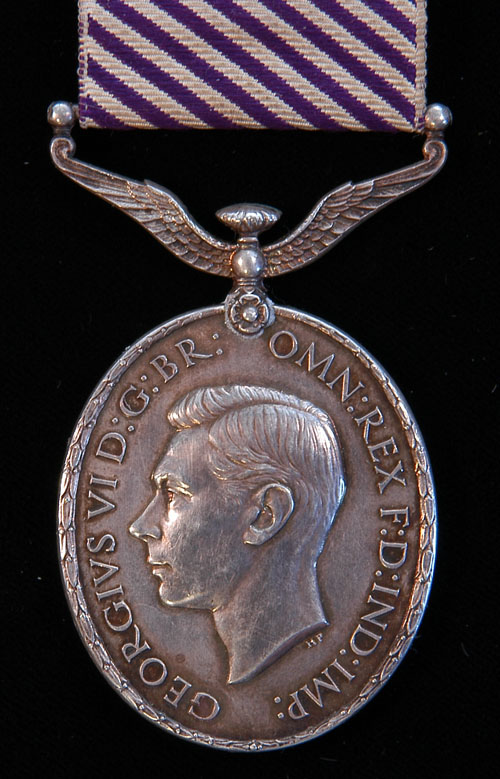
Auction: 6007 - Orders, Decorations, Campaign Medals & Militaria
Lot: 395
An ´Immediate´ Bomber Command, ´Evaders´ D.F.M. to Flight Sergeant J.E. Cope, Wellington Air Bomber, No. 115 Squadron, for Courage and Determination after he Bailed Out when his Aircraft was Shot Down over Nurnberg by a Night Fighter, and Evading Capture he made his way to Gibraltar, May to June 1943 Distinguished Flying Medal G.VI.R., 1st ´Ind: Imp:´ type (1377332. F/Sgt. J.E. Cope. R.A.F.), nearly extremely fine Estimate £ 2,200-2,500 D.F.M. London Gazette 18.5.1943 Flight Sergeant Jack Edward Cope No. 115 Squadron The Recommendation dated 21.4.1943 states ´This N.C.O. has completed a total of 22 operational sorties in this squadron as an Air Bomber. When his aircraft was shot down over Nuremberg, Flight Sergeant Cope landed rather heavily in his parachute and sustained a rupture. Despite this, he managed to make his way to Gibraltar and returned to this country a month after being shot down. Flight Sergeant Cope was an Air Bomber of the greatest courage and skill and always showed great courage and determination in the face of the enemy. He took part in raids on many of the more heavily defended targets including Bremen (4), Wilhelmshaven, Mainz (2) Duisburg (2), Dusseldorf, and Hamburg (2).´ Flight Sergeant Jack Edward Cope, D.F.M., born Hampstead, London, 1920; served with 115 Squadron, Marham, until September 1942, from Mildenhall September-November 1942, and from East Wretham from 8.11.1942; converted from Wellingtons to Lancasters, March 1943; Temporary Flight Sergeant 1.3.1943; Cope´s M.I.9. Personal Statement regarding his escape goes into greater detail than the Recommendation, ´I took off from Marham at about 2030 hrs on 28.8.1942 to bomb Nurnberg. We were shot down at about 2230hrs near Liege, Belgium, and I jumped at 10,000 feet. The rear gunner s [Hptm. Bietmann II./NJG1] saw a fighter in pursuit, after we had received a long burst of incendiary bullets which set fire to part of our fuselage and hydraulic system. This burst was encountered from Flak over Liege and probably killed the rear gunner, but I saw two members of the crew fixing their parachutes. After landing I did not see any of the others again.......... I landed in a turnip patch and could not bury my parachute. I therefore covered it up with turnip leaves and started walking. I saw the aircraft hit the ground and disintegrate. I walked for three hours in a South-westerly direction across fields and along tracks, avoiding villages. At about 0200 hrs I rested under a haystack in the village of Folx-Les-Caves, Belgium. At 0500 hrs I awoke and was seen by the farmer´s wife to whom I said, "Je suis anglais". She took me in and gave me food. I enquired where the nearest cure lived, he was not at home so I called at another farmhouse. This proved a wealthier household and I was given general refreshment, a complete set of civilian clothes and 1500 Belgian francs. At about 1100 hrs I was taken to Brussels by a member of the family and put in touch with an organisation which brought me back to the UK.´ Of the crew of five of Wellington III X3675 KO-D, three were killed in action, one was taken prisoner of war and Cope evaded capture. On this raid Wellingtons suffered 34 percent losses of aircraft.
Sold for
£2,600




